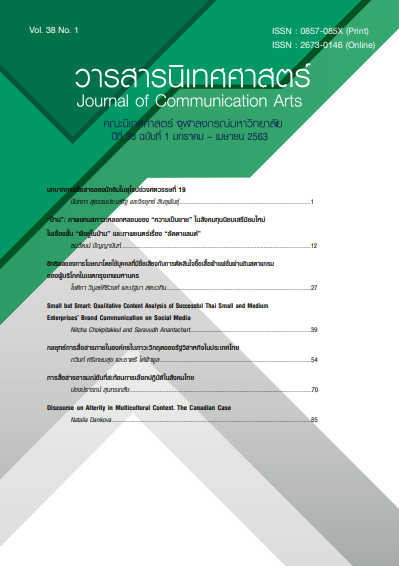Humor communication that reflects discrimination in Thai society
Main Article Content
Abstract
This article is about the humor communication of Thai people. The first objective is to analyze and review the issue of using jokes that reflect discrimination in Thai society, which is commonly overlooked, i.e., bodily jokes, sexual jokes, and racism jokes. The second objective is to create social awareness on negative humors. Some humor communication is the reproduction of sexism value, insulting the minority, violating listener's social norms, or it may be considered some forms of harassment. The author points out that bodily jokes, sexual jokes, and racism jokes may be offensive to the audience or hurt one’s feeling. Therefore, Thai society should create awareness on significant international principles, including discrimination; discrimination based on physical appearance or lookism; and harassment. In order to understand that creating new social etiquette about making joke is not a limitation of communication freedom, but respecting the rights and dignity of a person.
Article Details
References
ภาษาไทย
กรมคุ้มครองสิทธิและเสรีภาพ, กระทรวงยุติธรรม. (ม.ป.ป.). อนุสัญญาว่าด้วยการขจัดการเลือกปฏิบัติทางเชื้อชาติในทุกรูปแบบ. กรุงเทพฯ : บริษัท สไตล์ครีเอทีฟเฮ้าส์ จำกัด.
กระปุกดอทคอม. (2559). “ด่ายับ ข้าราชการหนุ่มแอบถ่ายเด็กปั๊ม บอกเป็นของแปลก-สัตว์หายาก”. วันที่เข้าถึงข้อมูล 2 สิงหาคม 2559 แหล่งที่มา https://hilight.kapook.com/view/140286
กล้า สมุทวณิช. (2559). “เรื่องล้อที่ไม่ใช่เล่น”. วันที่เข้าถึงข้อมูล 18 เมษายน 2562 แหล่งที่มา https://www.matichon.co.th/columnists/news_184830
เกษศิรินทร์ ศรีวราพิพัฒน์กุล. (2552). “อารมณ์ขันยุคไฮเท็ค: กรณีศึกษารูปแบบการนำเสนอมุกตลกแนวใหม่ในเรื่องขำขันผ่านทางด้านเนื้อหาและการใช้ภาษาในเว็บไซด์”. วันที่เข้าถึงข้อมูล 8 ตุลาคม 2551 แหล่งที่มา www.human..ac.th/~thai/sompong/res_ketsirin1.doc.
จุลศักดิ์ อมรเวช. (2542). วิธีคิดอารมณ์ขัน. กรุงเทพฯ : เยลโล่การพิมพ์.
ชาลิดา อรัญทิมา. (2560). ตลกหญิง: การสื่อสารกับการต่อรองพื้นที่ตลกในสื่อโทรทัศน์ไทย. วิทยานิพนธ์ หลักสูตรวารสาร
ศาสตรมหาบัณฑิต (สื่อสารมวลชน) คณะวารสารศาสตร์และสื่อสารมวลชน มหาวิทยาลัยธรรมศาสตร์.
ทรงศักดิ์ ปรางค์วัฒนากุล. (2532). การศึกษาเปรียบเทียบคำอู้บ่าวสาวล้านนาและและผญาเกี้ยวอีสาน. กรุงเทพฯ : โอเดียนสโตร์.
ปฐม ทรัพย์เจริญ. (2550). การควบคุมทางสังคม: สังคมวิทยาและมานุษยวิทยาเบื้องต้น. กรุงเทพฯ: สํานักพิมพมหาวิทยาลัยรามคําแหง.
ประชาไท. (2551). “ซิตคอม “มุขแป้ก” มีเดียมอนิเตอร์ไม่ขำมุขเหยียดเพศ ภูมิลำเนา หน้าตา” วันที่เข้าถึงข้อมูล 30 มกราคม 2562 แหล่งที่มา https://prachatai.com/journal/2008/03/16015
ปองปรารถน์ สุนทรเภสัช. (2553). “ความรุนแรงทางเพศต่อผู้หญิงที่สะท้อนในหนังสือการ์ตูนไทย”.เอกสารประกอบการประชุมทางวิชาการและการนำเสนอผลงานวิจัยประจำปี 2553 วันที่ 8 เมษายน 2553 ณ อาคารสัมมนา 1 มหาวิทยาลัยสุโขทัยธรรมาธิราช. 67-78.
________. (2559). “การส่งข้อความหรือภาพเรื่องเพศ : ผลกระทบต่อวัยรุ่นลำปางและนัยทางกฎหมาย”, วารสารวิชาการ วารสารวิทยการจัดการสมัยใหม่. 9(1): 121-137.
________. (2562). “อคติทางชาติพันธุ์ที่มีต่อสาธารณรัฐประชาธิปไตยประชาชนลาวในสังคมไทยที่ปรากฏในสื่อสังคมออนไลน์”. ลำปาง : มหาวิทยาลัยราชภัฏลำปาง.
ปิยบุตร แสงกนกกุล. (2562). “วิวาทะ “ปิยบุตร” โพสต์เรื่องคนอีสานถูกทำให้เชื่อว่าเป็นคนตลก เป็นแรงงาน ไม่มีความรู้”.วันที่เข้าถึงข้อมูล 22 เมษายน 2562 แหล่งที่มา https://workpointnews.com/2019/02/20/วิวาทะ-ปิยบุตร-โพสต์
ผู้จัดการออนไลน์. (2559). “มุกตลกไทย...ที่ชาวโลกไม่ตลก! ปล่อยฮา “Please Stand Up” ใส่คนแคระ!”. วันที่เข้าถึงข้อมูล 30 มกราคม 2562 แหล่งที่มา https://mgronline.com/live /detail/ 9590000034226
ภาวดี สายสุวรรณ. (2557). “ค่านิยมที่สะท้อนในมุกตลกในการ์ตูนช่องของไทย”. ดำรงวิชาการ. 9(2):135-163.
ราชบัณฑิตยสถาน. (2556). พจนานุกรม ฉบับราชบัณฑิตยสถาน พ.ศ. 2554 เฉลิมพระเกียรติพระบาทสมเด็จ
พระเจ้าอยู่หัวเนื่องในโอกาสพระราชพิธีมหามงคลเฉลิมพระชนมพรรษา 7 รอบ 5 ธันวาคม 2554. กรุงเทพฯ: ราชบัณฑิตยสถาน.
วัลลภ ปิยะมโนธรรม (2562). “9 ประโยชน์อารมณ์ขัน ช่วยอายุยืน”. สืบค้นเมื่อวันที่ 23 มกราคม 2562 จาก https://goodlifeupdate.com/healthy-body/health-education/ 63394.html
วรรณนิภา วงค์ปัญญา. มิติบริบทในการกระตุ้นอารมณ์ขันในการแสดงตลกเดี่ยว. วิทยานิพนธ์ศิลปศาสตร มหาบัณฑิต สาขาวิชาภาษาศาสตร์เพื่อการสื่อสาร ภาควิชาภาษาศาสตร์ คณะศิลปศาสตร์ มหาวิทยาลัย ธรรมศาสตร์.
ศรีสุรีย์ เอื้อจิระพงษ์พันธ์. (2541). อารมณ์ขัน: เครื่องมือในการบริหารการพยาบาล. รามาธิบดีพยาบาลสาร, 4(3), 311 - 317.
สมเกียรติ ตั้งนโม. (2551). “เงื่อนไข 6 ประการของเรื่องตลก”. วันที่เข้าถึงข้อมูล 8 ตุลาคม 2551 แหล่งที่มา https://www.midnightuniv.org/midnightuniv/newpage61.htm
สยาม เจริญอินทร์พรหม. (2553). การเล่าเรื่อง อารมณ์ขัน และบริบททางสังคมในภาพยนตร์ตลกไทยร่วมสมัย. วิทยานิพนธ์ศิลปศาสตรมหาบัณฑิต (สื่อสารมวลชน). มหาวิทยาลัยรามคำแหง.
สุรพล บัณฑุเศรณี, (2539). “วัฒนธรรมตลกร่วมสมัย ตลกคาเฟ่กับตลกปัญญาชน มองปรากฏการณ์กระจก 6 ด้าน” วันที่เข้าถึงข้อมูล 24 ธันวาคม 2561 แหล่งที่มา https://www.silpa-mag.com/culture/article_24923
หทัยวรรณ ไชยะกุล. (2539). การสร้างมุกตลกในเรื่องขำขันของล้านนา. วิทยานิพนธ์ศิลปศาสตรมหาบัณฑิต สาขาภาษาและวรรณกรรมล้านนา. บัณฑิตวิทยาลัย. มหาวิทยาลัยเชียงใหม่.
เอื้อจิต วิโรจน์ไตรรัตน์. (2551). “มุกฮาซิตคอม” ขำ ๆ แบบสร้างอคติ.” วันที่เข้าถึงข้อมูล 30 มกราคม 2562 แหล่งที่มา https://mgronline.com/qol/detail/9510000030024
ภาษาอังกฤษ
Beeman, W. (2000). Humor. Journal of Linguistic Anthropology 9(1-2), 103-106
Chen, G., and Martin, R. A. (2007). A comparison of humor styles, coping humor, and mental health between Chinese and Canadian university students. International Journal of Humor Research. 20(3), 215–234.
Chukwuka, U. (2019). Sexual abuse and the health implications on women in Western Illinois University. Thesis. Master of Science. Western Illinois University.
Eagly, A. H., Ashmore, R. D., Makhijani, M. G., & Longo, L. C. (1991). What is beautiful is good, but…: A meta-analytic review of research on the physical attractiveness stereotype. Psychological Bulletin, 110(1), 109–128.
Fessler, L. (2017). The damning big-picture consequences of making crude jokes at work. Retrieved December 28, 2017 from https://qz.com/work/1167257/new-york-times-survey-shows-that-dirty-jokes-are-linked-to-sexual-harassment/
Gray, J.A. (2011). The Role of Context in the Interpretation of Sexist Humor. Thesis. Master of Arts in English. Western Carolina University.
Greenberg, M. (1979). Sexual Humor Appreciation and Its Relationship to Gender, Sex-Role Attitude and Sexist Humor Type. Dissertation. PhD California School of Professional Psychology, Los Angeles.
Martin, R., and Ford, T. (2018). The Psychology of Humor: An Integrative pproach. Burlington, MA: Elsevier Academic Press.
Moore, T.E., Karen, G and Barbara, P. (1987). “Gender, attitudes towards women, and the appreciation of sexist humor”. Sex Roles 16(9/10): 521–531.
Morreal, J. (1987). The Philosophy of Laughter and Humor. New York: State University of New York Press.
Rhodes, G.; Simmons, L. and Peters, M. (2005). "Attractiveness and sexual behavior : Does attractiveness enhance mating success?". Evolution and Human Behavior. 26(2): 186–201.
Ryan, K.M. and Kanjorski, J. (1998). “The enjoyment of sexist humor, rape attitudes, and relationship aggression in college students”. Sex Roles. 38(9/10): 743-756.
Scarpetta, F. and Spagnolli, A. (2009). The interaction context of humor in stand-up comedy. Language and Social Interaction 42(3): 1-22.
Soonthornpasuch, P. (2007). Sexual harassment: perceptions, policies and laws in Thailand. PhD Thesis. Women’s and Gender Studies. University of New South Wales.
Taflinger, R.F. (1996). “Sitcom: What it is, How it works”. A Theory of Comedy. [Online]. Retrieved April 22, 2019. From https://public.wsu.edu/~taflinge/theory.html


